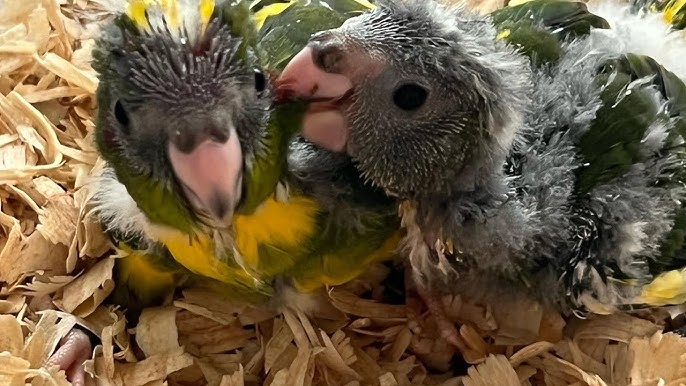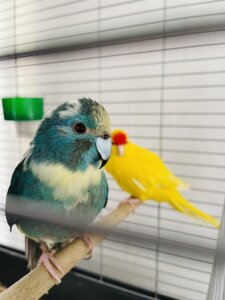How to Care for a Kakariki?
Caring for a Kakariki is rewarding and fun. These vibrant parrots are lively and affectionate.
Kakarikis, also known as New Zealand parakeets, are small, colorful birds. They thrive in a loving and attentive environment. This blog will guide you through the essentials of Kakariki care. From diet to habitat, we’ll cover it all. These birds have unique needs that are easy to meet with the right knowledge.
Proper care ensures your Kakariki stays healthy and happy. Understanding their behavior and requirements is key. Let’s dive into the world of Kakariki care and learn how to keep these delightful birds thriving.

Credit: www.birdcagesnow.com
Choosing The Right Cage
Choosing the right cage is crucial for your Kakariki’s well-being. A good cage provides a safe and comfortable environment. It also ensures your bird has enough space to play and exercise.
Size And Space
When selecting a cage, size matters. Kakarikis are active birds. They need room to move around. A small cage can restrict their movement, leading to stress and health issues.
Minimum dimensions for a Kakariki cage should be 24x24x24 inches. This allows them to stretch their wings and hop around. Larger cages are always better. If you can, choose a cage that is wider than it is tall. This design provides more horizontal space for your bird to explore.
| Cage Size | Bird Comfort |
|---|---|
| 24x24x24 inches | Basic comfort |
| 30x30x30 inches | Optimal comfort |
Safe Materials
Safety is a top priority. The materials of the cage should be bird-safe. Avoid cages with lead or zinc coatings. These can be toxic if ingested.
Choose cages made of stainless steel or powder-coated metal. These materials are durable and safe. Make sure the bars are spaced correctly. Bar spacing should not exceed 0.5 inches to prevent your Kakariki from getting stuck.
- Stainless steel
- Powder-coated metal
- Proper bar spacing
Lastly, ensure the cage has no sharp edges. Sharp edges can injure your bird. Regularly check for any damage or wear and tear. Replace the cage if it becomes unsafe.

Credit: parrotessentials.co.uk
Diet And Nutrition
Ensuring a balanced diet and proper nutrition is vital for the health of your Kakariki. These small parrots have specific dietary needs that must be met to keep them healthy and happy. A varied diet helps prevent nutritional deficiencies and promotes overall well-being.
Fresh Foods
Fresh foods should make up a large part of your Kakariki’s diet. Offer a mix of fruits and vegetables daily. Good choices include apples, carrots, broccoli, and leafy greens. Always wash fruits and vegetables thoroughly. Remove any seeds and pits from fruits before serving. Fresh foods not only provide essential nutrients but also keep your bird engaged.
Supplements And Treats
Supplements can help fill any gaps in your Kakariki’s diet. A calcium supplement is important, especially for egg-laying females. Offer cuttlebone or mineral blocks to provide necessary minerals. Limit treats to avoid obesity. Millet sprays and small pieces of nuts make excellent occasional treats. Always offer fresh water alongside their meals.
Daily Exercise
Caring for a Kakariki involves more than just feeding and cleaning. These vibrant birds require daily exercise to stay healthy and happy. Regular activity helps them burn off energy, maintain a healthy weight, and stay mentally sharp. Here, we discuss two key components of daily exercise: free-flying time and interactive toys.
Free-flying Time
Allowing your Kakariki to fly freely every day is essential. This exercise strengthens their muscles and improves cardiovascular health. Create a safe space for them to fly indoors. Ensure that windows and doors are closed. Remove any dangerous items that could harm your bird.
Free-flying should last at least an hour. If possible, extend this time to two hours. Supervise your Kakariki during this period to prevent accidents. A consistent routine will help your bird feel secure and establish good habits.
Interactive Toys
Interactive toys are crucial for keeping your Kakariki engaged. They provide mental stimulation and prevent boredom. Choose toys that encourage physical activity, like swings and ladders. Rotate toys regularly to maintain interest.
Here are some suggestions for interactive toys:
- Swings: Great for balance and coordination.
- Ladders: Promote climbing and exercise.
- Foraging Toys: Encourage natural behaviors and problem-solving skills.
- Chew Toys: Help with beak maintenance and stress relief.
Place these toys in various locations within the cage. Ensure they are safe and made of non-toxic materials. Monitor your Kakariki’s interaction with the toys to ensure they are not harmful.
Social Interaction
Social Interaction is crucial for the well-being of your Kakariki. These playful parrots thrive on companionship and engagement. Proper social interaction ensures your bird stays happy and healthy. Let’s explore the key aspects of social interaction: Bonding with Your Parrot and Introducing New Birds.
Bonding With Your Parrot
Building a strong bond with your Kakariki is rewarding. Spend quality time with your bird daily. Talk to your parrot softly and use its name often. Offer treats by hand to gain trust.
- Play interactive games with toys.
- Engage in gentle petting and head scratches.
- Allow your bird to perch on your shoulder.
Consistency is key. Daily interaction strengthens your bond. Your Kakariki will begin to recognize and trust you more each day.
Introducing New Birds
Introducing a new bird to your Kakariki requires patience. Ensure the new bird is healthy and quarantined for 30 days.
- Place the new bird’s cage near the existing one.
- Allow the birds to see each other but not touch.
- Observe their behavior for signs of aggression or curiosity.
Gradually increase their interaction time. Supervise their interactions closely. Provide separate feeding areas to prevent territorial disputes.
With time, your Kakariki will accept the new companion. Proper introduction helps in creating a harmonious environment for both birds.
Maintaining Health
Maintaining the health of your Kakariki is crucial for a long, happy life. These lively birds need proper care and attention. Regular check-ups and knowing common health issues can help prevent problems.
Regular Vet Visits
Schedule regular vet visits for your Kakariki. Annual check-ups are essential. They help in early detection of potential issues. A vet experienced with birds is best. They can provide tailored advice and treatments.
Common Health Issues
Be aware of common health issues in Kakarikis. Respiratory infections are common. Signs include sneezing, wheezing, or nasal discharge. Feather plucking is another concern. It can indicate stress or illness. A balanced diet and clean environment can prevent many problems.
Watch for signs of illness. Changes in behavior or appetite are red flags. Quick action can save your bird’s life. Keep your Kakariki healthy and happy with good care.

Credit: www.pinterest.com
Grooming Needs
Kakarikis, vibrant and active parrots, require regular grooming to stay healthy. Proper grooming ensures they look good and feel comfortable. Let’s explore the grooming needs of your Kakariki.
Feather Care
Feather care is essential for Kakarikis. These birds love to preen and keep their feathers clean. Provide a shallow dish of water for bathing. This helps them remove dust and dirt. You can mist them with water to aid in cleaning. Ensure their cage is clean to prevent feather issues. Remove loose feathers to maintain cleanliness.
Nail Trimming
Nail trimming is necessary to prevent overgrowth. Long nails can cause discomfort and injury. Use a small bird nail clipper for trimming. Be careful not to cut too close to the quick. The quick is the blood vessel inside the nail. If unsure, seek help from a vet or professional groomer. Regular trimming keeps your Kakariki comfortable and healthy.
Creating A Stimulating Environment
Creating a stimulating environment for your Kakariki is essential. This ensures they stay happy and healthy. These energetic parrots need mental and physical stimulation daily. A well-designed environment can reduce stress and boredom.
Enrichment Activities
Provide a variety of toys for your Kakariki. Rotate them weekly to keep things fresh. Puzzle toys with hidden treats can challenge their minds. Hanging toys encourage climbing and swinging. Both are great for exercise. Interactive playtime with you also boosts their mood.
Safe Plants And Perches
Incorporate safe plants in their environment. Plants like spider plants and African violets are non-toxic. They add greenery and a natural feel. Natural wood perches are ideal. They help wear down their nails and beaks. Ensure the wood is untreated and safe for birds. Varying perch sizes keep their feet healthy. Place perches at different heights to encourage movement.
Training And Behavior
Caring for a Kakariki involves understanding their training needs and behaviors. These birds are intelligent and social, making them perfect for training. With proper guidance, you can teach them basic commands and address any behavioral problems.
Basic Commands
Start by teaching your Kakariki simple commands. Use consistent phrases and gestures for each command. Here are some basic commands to begin with:
- Step Up: Hold your finger near the bird’s chest. Say “Step Up” to encourage them to step onto your finger.
- Step Down: Move your finger to a perch or surface. Say “Step Down” to guide them off your finger.
- Come Here: Use a treat to lure your Kakariki. Say “Come Here” and reward them when they reach you.
Repeating these commands daily helps reinforce the learning. Always reward good behavior with treats or praise.
Addressing Behavioral Problems
Even well-trained Kakarikis can develop behavioral problems. Common issues include biting, screaming, and feather plucking. Address these problems with patience and consistency.
Biting: If your Kakariki bites, do not react aggressively. Stay calm and gently say “No.” Offer a toy or treat to redirect their attention.
Screaming: Excessive screaming often occurs when they feel lonely. Ensure they have enough social interaction and mental stimulation. Provide toys and engage in regular playtime.
Feather Plucking: This can be a sign of stress or boredom. Make sure your Kakariki has a variety of toys and activities. Consult a vet if the behavior persists.
Addressing behavioral issues early is key. Use positive reinforcement and be consistent with your approach.
| Behavior | Solution |
|---|---|
| Biting | Stay calm, say “No,” redirect with a toy or treat |
| Screaming | Ensure social interaction, provide toys, engage in playtime |
| Feather Plucking | Provide variety of toys, consult a vet if needed |
Training and behavior management are essential for a happy, healthy Kakariki. With patience and consistency, you can create a strong bond with your feathered friend.
Frequently Asked Questions
How Often Should I Feed My Kakariki?
Feed your Kakariki twice daily with a balanced diet. Include seeds, pellets, fruits, and vegetables. Avoid overfeeding.
What Is The Best Cage Size For Kakariki?
A spacious cage is essential. Minimum size: 24″x18″x18″. Larger cages encourage exercise and mental stimulation.
How Do I Keep My Kakariki Entertained?
Provide toys, perches, and regular out-of-cage time. Rotate toys weekly to maintain interest and prevent boredom.
What Are Common Health Issues In Kakarikis?
Watch for respiratory issues, feather plucking, and obesity. Regular vet check-ups ensure early detection and treatment.
Conclusion
Caring for a Kakariki bird can be rewarding and fun. Provide a balanced diet and fresh water daily. Ensure a spacious and clean cage for their comfort. Regular interaction keeps them happy and social. Don’t forget to visit the vet for routine check-ups.
With proper care, your Kakariki will thrive and bring joy to your home. Enjoy the companionship of your colorful, lively friend!
Hello Dear, I'm Poli Kolymnia, owner of many birds (including budgies).
With a deep passion for these feathered companions, I'm here to share my expertise and extensive knowledge on birds care.
My articles cover essential topics like diet, housing, care, and health, providing practical tips to help you create a happy and thriving environment for your birds.





